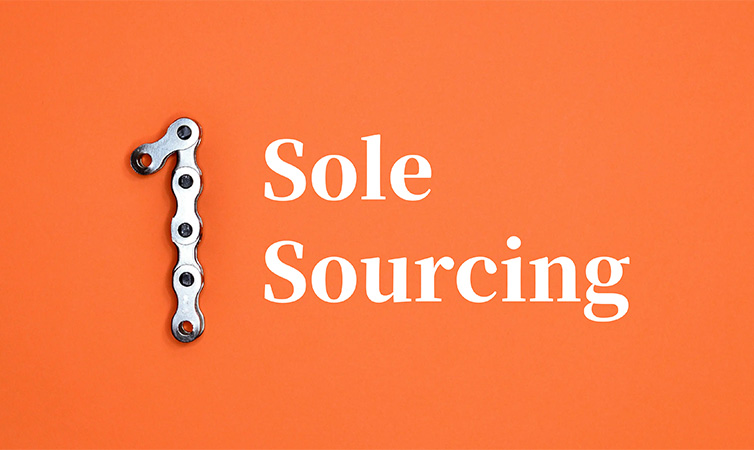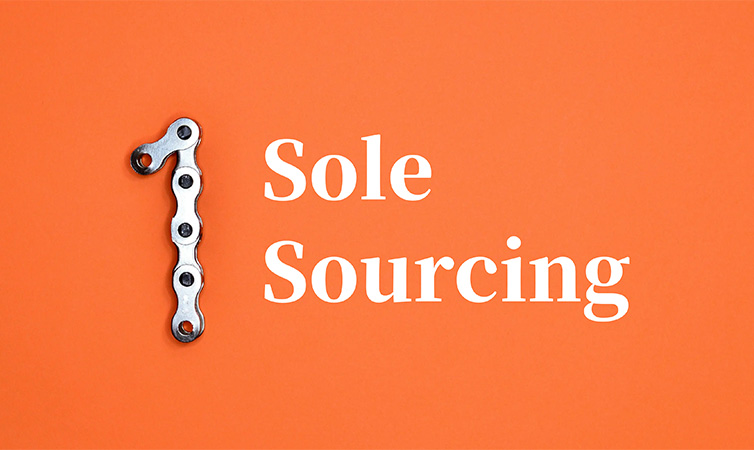
What is sole sourcing?
Sole sourcing refers to a purchasing method where commodity circulation enterprises exclusively purchase a certain type of commodity from a single supplier, excluding other suppliers.

In simple terms, it means that a company purchases the goods or services it needs exclusively from a specific supplier, without considering other suppliers. This type of procurement is usually used to ensure the stability of supply, consistency of quality, or because of some special reasons, such as technological monopoly, patent protection, etc., which leads to only one suitable supplier in the market.
Unlike diversified procurement, which mitigates risks and ensures competition by using multiple suppliers, sole sourcing involves a dedicated partnership with one supplier. Sole sourcing can simplify the procurement process, promote closer supplier relationships, and potentially lead to cost savings and efficiency improvements.
Exclusive procurement may also bring some risks, such as supply disruptions, unfavorable prices, etc., so companies need to consider carefully when adopting this approach.
What are the characteristics of sole sourcing?
The characteristics of sole sourcing are mainly reflected in the following aspects:
Sole sourcing of suppliers
The core characteristic of sole sourcing is to purchase the required goods or services from only one supplier. The relationship between the purchaser and the supplier is relatively close, usually involving long-term cooperation and mutual dependence.
The concentration of purchasing volume
Purchasing from only one supplier, the procurement volume is relatively concentrated. The purchaser obtains better price discounts or quantity discounts, and the supplier is usually willing to provide more competitive prices for bulk purchases.
Long-term cooperation
Sole sourcing often comes with long-term partnerships. The purchaser and supplier will establish stable business connections, jointly plan and develop the supply chain, ensuring the maximization of benefits for both parties.

Click the image to learn more
Quality stability
Purchasing from only one supplier allows the purchaser to more easily ensure the quality stability of goods or services. This reduces the risks associated with product quality differences between suppliers.
Simplified management
Sole sourcing simplifies the procurement management process. The purchaser only needs to communicate and coordinate with one supplier, reducing the time and cost of dealing with multiple suppliers.
Risks and opportunities coexist
While sole sourcing brings many advantages, it also comes with certain risks. For example, supply disruptions, unfavorable prices, and excessive dependence. Therefore, the purchaser needs to comprehensively assess the risks and opportunities when choosing sole sourcing.
Sole sourcing has characteristics such as uniqueness of suppliers, centralization of purchasing volume, long-term cooperation, quality stability, management simplification, and coexistence of risks and opportunities.
When deciding whether to adopt sole sourcing, enterprises should fully consider these characteristics and make a wise choice based on their own needs and market environment.
The potential risks of sole sourcing
While sole sourcing brings many advantages, such as the stability of supplier relationships, consistency in product quality, and simplification of management processes, it also comes with some potential risks.
Here are the main potential risks of sole sourcing:
Risk of supply interruption
Exclusive suppliers may fail to deliver on time due to various reasons (such as production failures, natural disasters, financial issues, etc.), leading to disruptions in the purchaser's supply chain, affecting production and sales. Recovering from these disruptions may be more difficult and time-consuming when there are no alternative suppliers.
Price risk
Sole sourcing lacks sufficient market competition, and the purchaser may be at a disadvantage in price negotiations, leading to higher purchase prices or inability to obtain more favorable purchasing conditions. Without the pressure of competitive bidding, a single supplier may lack the incentive to offer competitive prices, resulting in increased costs for the company.
Quality risk
Sole sourcing suppliers can usually ensure the consistency of product quality. If there are problems with their quality control system, the purchaser may face the risk of batches of products not meeting quality standards.
Dependency risk
Long-term dependence on a single supplier may make the purchaser vulnerable in the supply chain, increasing the risk of supply chain disruption. Once this supplier encounters production problems, financial problems, or other challenges, it may seriously affect the company's ability to obtain necessary goods or services. The purchaser may find it difficult to quickly find an alternative supplier.
Innovation risk
Sole sourcing may limit the purchaser's access to new technologies and new suppliers, affecting its innovation capability and market competitiveness.
Integrity risk
In the process of sole sourcing, there may be situations where suppliers promote cooperation through improper means, increasing the risk of corruption for procurement and related personnel.
Contract risk
Exclusive sourcing contracts usually involve a long cooperation period and complex terms. If the contract terms are unclear or have loopholes, it may lead to legal disputes and economic losses for the purchaser.
In order to reduce these potential risks, the purchaser should conduct a comprehensive risk assessment when adopting the sole sourcing strategy, formulate corresponding risk management plans, and establish long-term, mutually beneficial cooperative relationships with suppliers.
The purchaser should also maintain market sensitivity in order to quickly adjust the purchasing strategy when necessary.
Under what circumstances can we initiate sole sourcing?
The timing of choosing sole sourcing instead of diversified procurement usually depends on a variety of factors, including the business needs of the enterprise, market environment, cost control, quality control, and risk tolerance.
The following are some situations that may be suitable for choosing sole sourcing:
1. Business requirements and product quality
When a company has extremely high requirements for the quality of the purchased goods or services, and there is only one supplier in the market that can meet these requirements, sole sourcing becomes an inevitable choice. In this case, the technical strength, production experience, and quality control system of the sole supplier may be unmatched by other suppliers.
If a company needs to purchase goods or services that are highly customized, and there are only a few or even only one supplier in the market that can provide such services, then sole sourcing may be the most efficient choice. Ensure that the supplier fully understands the company's needs and provides a solution that meets expectations.
2. Cost control and efficiency
When the procurement volume reaches a certain scale, the sole sourcing may provide more attractive price discounts or preferential conditions. The enterprise reduces procurement costs and improves economic efficiency.
Sole sourcing simplifies the procurement management process, reducing the time and cost of communicating with multiple suppliers. The buyer only needs to establish a stable cooperative relationship with one supplier to ensure the smooth operation of the supply chain. It is of great significance for improving management efficiency and reducing management costs.
3. Risk management and stability
In some cases, sole sourcing may have stronger supply stability and reliability. For example, sole sourcing may have more advanced production equipment, more comprehensive logistics systems, and stronger inventory management capabilities, ensuring timely delivery and reducing the risk of supply disruptions.
For certain key components or raw materials, sole sourcing may help reduce supply chain risks. By establishing long-term partnerships with sole suppliers, companies can ensure stable supply support in emergency situations, avoiding production stalling or economic losses due to supply chain disruptions.
4. Special Situations and Strategic Considerations
In some industries or regions, there may be legal or policy requirements that mandate companies to adopt the sole sourcing model. For example, the procurement of certain special goods or services may be restricted by government regulations or industry norms, requiring companies to purchase only from specific suppliers.
Sometimes, in order to implement a specific market strategy or supply chain strategy, a company may choose the sole sourcing model. For example, in order to establish a long-term cooperative relationship with a key supplier, jointly develop new products, or enter new markets, a company may choose sole sourcing to ensure the stability and competitiveness of the supply chain.



